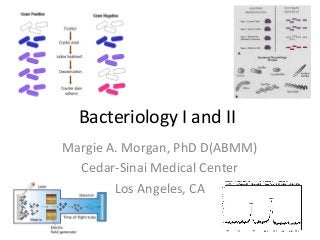Osler bacteriology-i-and-ii-2013-new
•Télécharger en tant que PPT, PDF•
6 j'aime•471 vues
Signaler
Partager
Signaler
Partager

Recommandé
Contenu connexe
En vedette
En vedette (15)
Plus de Margie Morgan
Plus de Margie Morgan (20)
Mycology Update February 2024 Microbes with Morgan

Mycology Update February 2024 Microbes with Morgan
Osler bacteriology-i-and-ii-2013-new
- 1. Bacteriology I and II Margie A. Morgan, PhD D(ABMM) Cedar-Sinai Medical Center Los Angeles, CA
- 2. Beginning definitions • Obligate Aerobe – require oxygen (20%) to grow • Obligate Anaerobe –>30 min of oxygen exposure can be toxic • Facultative anaerobes – grow in aerobic and anaerobic conditions, most “aerobic” bacteria are actually facultative • Microaerophilic – Grow better with reduced oxygen and elevated Carbon dioxide % • Aerotolerant anaerobes– anaerobe not killed by prolonged exposure to oxygen – example: Clostridium tertium • Lag Phase - >24 hrs old, growth slowing, not appropriate for biochemical or susceptibility testing • Log Phase – Exponential growth – appropriate for all testing • Stationary phase – appropriate for transporting specimens
